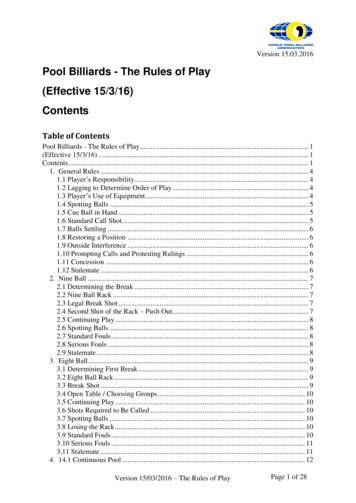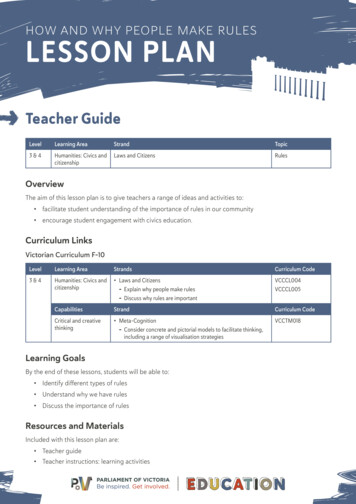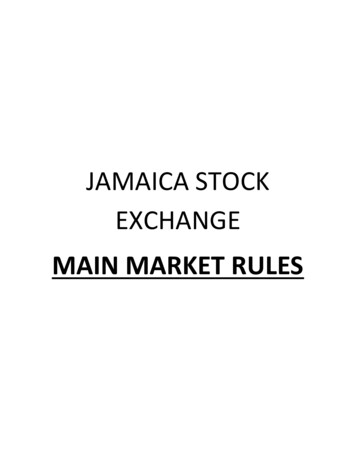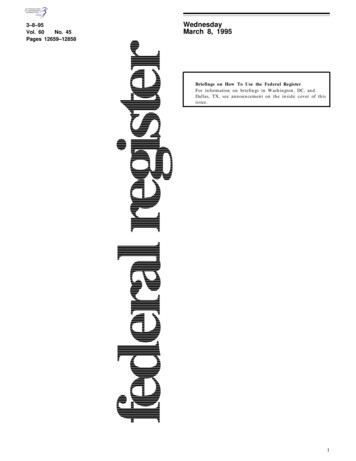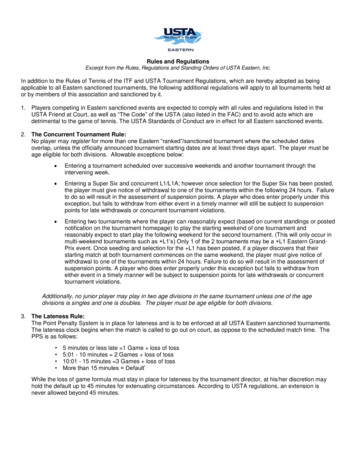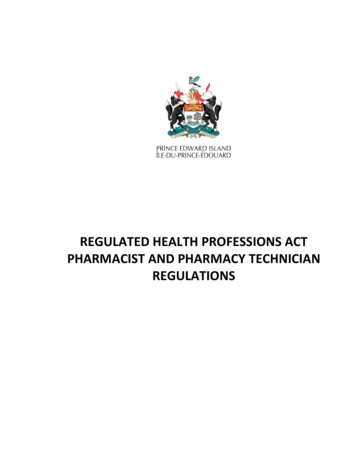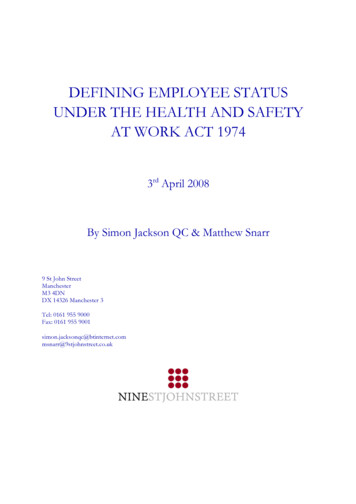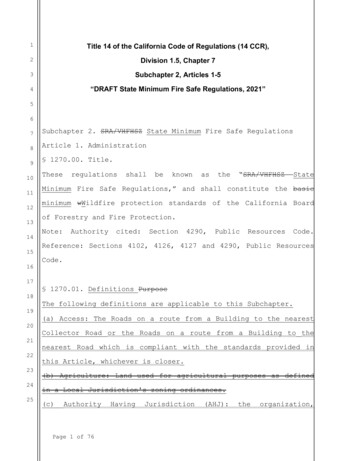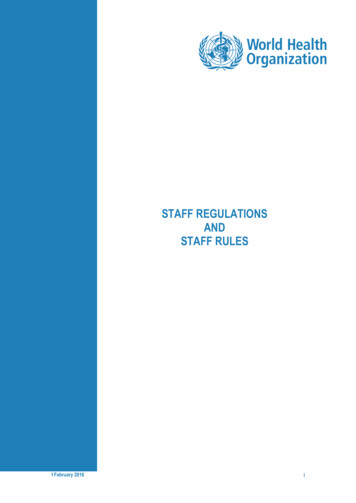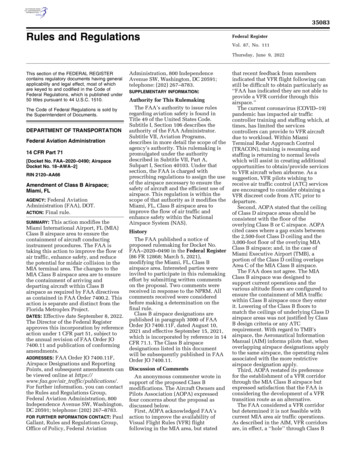
Transcription
35083Rules and RegulationsFederal RegisterVol. 87, No. 111Thursday, June 9, 2022This section of the FEDERAL REGISTERcontains regulatory documents having generalapplicability and legal effect, most of whichare keyed to and codified in the Code ofFederal Regulations, which is published under50 titles pursuant to 44 U.S.C. 1510.The Code of Federal Regulations is sold bythe Superintendent of Documents.DEPARTMENT OF TRANSPORTATIONFederal Aviation Administration14 CFR Part 71[Docket No. FAA–2020–0490; AirspaceDocket No. 18–AWA–2]RIN 2120–AA66Amendment of Class B Airspace;Miami, FLFederal AviationAdministration (FAA), DOT.ACTION: Final rule.AGENCY:This action modifies theMiami International Airport, FL (MIA)Class B airspace area to ensure thecontainment of aircraft conductinginstrument procedures. The FAA istaking this action to improve the flow ofair traffic, enhance safety, and reducethe potential for midair collision in theMIA terminal area. The changes to theMIA Class B airspace area are to ensurethe containment of arriving anddeparting aircraft within Class Bairspace as required by FAA directivesas contained in FAA Order 7400.2. Thisaction is separate and distinct from theFlorida Metroplex Project.DATES: Effective date September 8, 2022.The Director of the Federal Registerapproves this incorporation by referenceaction under 1 CFR part 51, subject tothe annual revision of FAA Order JO7400.11 and publication of conformingamendments.ADDRESSES: FAA Order JO 7400.11F,Airspace Designations and ReportingPoints, and subsequent amendments canbe viewed online at https://www.faa.gov/air traffic/publications/.For further information, you can contactthe Rules and Regulations Group,Federal Aviation Administration, 800Independence Avenue SW, Washington,DC 20591; telephone: (202) 267–8783.FOR FURTHER INFORMATION CONTACT: PaulGallant, Rules and Regulations Group,Office of Policy, Federal Aviationlotter on DSK11XQN23PROD with RULES1SUMMARY:VerDate Sep 11 201416:19 Jun 08, 2022Jkt 256001Administration, 800 IndependenceAvenue SW, Washington, DC 20591;telephone: (202) 267–8783.SUPPLEMENTARY INFORMATION:Authority for This RulemakingThe FAA’s authority to issue rulesregarding aviation safety is found inTitle 49 of the United States Code.Subtitle I, Section 106 describes theauthority of the FAA Administrator.Subtitle VII, Aviation Programs,describes in more detail the scope of theagency’s authority. This rulemaking ispromulgated under the authoritydescribed in Subtitle VII, Part A,Subpart I, Section 40103. Under thatsection, the FAA is charged withprescribing regulations to assign the useof the airspace necessary to ensure thesafety of aircraft and the efficient use ofairspace. This regulation is within thescope of that authority as it modifies theMiami, FL, Class B airspace area toimprove the flow of air traffic andenhance safety within the NationalAirspace System (NAS).HistoryThe FAA published a notice ofproposed rulemaking for Docket No.FAA–2020–0490 in the Federal Register(86 FR 12868; March 5, 2021),modifying the Miami, FL, Class Bairspace area. Interested parties wereinvited to participate in this rulemakingeffort by submitting written commentson the proposal. Two comments werereceived in response to the NPRM. Allcomments received were consideredbefore making a determination on thefinal rule.Class B airspace designations arepublished in paragraph 3000 of FAAOrder JO 7400.11F, dated August 10,2021 and effective September 15, 2021,which is incorporated by reference in 14CFR 71.1. The Class B airspacedesignations listed in this documentwill be subsequently published in FAAOrder JO 7400.11.Discussion of CommentsAn anonymous commenter wrote insupport of the proposed Class Bmodifications. The Aircraft Owners andPilots Association (AOPA) expressedfour concerns about the proposal asdiscussed below.First, AOPA acknowledged FAA’saction to improve the availability ofVisual Flight Rules (VFR) flightfollowing in the MIA area, but statedPO 00000Frm 00001Fmt 4700Sfmt 4700that recent feedback from membersindicated that VFR flight following canstill be difficult to obtain particularly as‘‘FAA has indicated they are not able toprovide a VFR corridor through thisairspace.’’The current coronavirus (COVID–19)pandemic has impacted air trafficcontroller training and staffing which, attimes, has limited the servicescontrollers can provide to VFR aircraftdue to workload. Within MiamiTerminal Radar Approach Control(TRACON), training is resuming andstaffing is returning to normal levelswhich will assist in creating additionalopportunities to obtain/provide servicesto VFR aircraft when airborne. As asuggestion, VFR pilots wishing toreceive air traffic control (ATC) servicesare encouraged to consider obtaining aVFR discreet code from ATC prior todeparture.Second, AOPA stated that the ceilingof Class D airspace areas should beconsistent with the floor of theoverlying Class B or C airspace. AOPAcited cases where a gap exists betweenthe 2,500-foot Class D ceiling and the3,000-foot floor of the overlying MIAClass B airspace; and, in the case ofMiami Executive Airport (TMB), aportion of the Class D ceiling overlapsArea C of the MIA Class B airspace.The FAA does not agree. The MIAClass B airspace was designed tosupport current operations and thevarious altitude floors are configured toensure the containment of MIA trafficwithin Class B airspace once they enterit. Lowering of the Class B floors tomatch the ceilings of underlying Class Dairspace areas was not justified by ClassB design criteria or any ATCrequirement. With regard to TMB’sairspace, the Aeronautical InformationManual (AIM) informs pilots that, whenoverlapping airspace designations applyto the same airspace, the operating rulesassociated with the more restrictiveairspace designation apply.Third, AOPA restated its preferencefor the establishment of a VFR corridorthrough the MIA Class B airspace butexpressed satisfaction that the FAA isconsidering the development of a VFRtransition route as an alternative.The FAA considered a VFR corridorbut determined it is not feasible withcurrent MIA area air traffic operations.As described in the AIM, VFR corridorsare, in effect, a ‘‘hole’’ through Class BE:\FR\FM\09JNR1.SGM09JNR1
35084Federal Register / Vol. 87, No. 111 / Thursday, June 9, 2022 / Rules and Regulationsairspace in which aircraft can operatewithout an ATC clearance orcommunication with ATC. Consideringlocal constraints, including trafficvolume and traffic flows, plus the closeproximity of numerous airports in theMIA area, a VFR corridor could not beestablished for operational and flightsafety reasons.As an alternative, the FAA designedand implemented VFR TransitionRoutes which became effectivebeginning with the February 25, 2021,aeronautical charting cycle. The routescurrently are depicted on the MiamiVFR Terminal Area Chart (TAC), andthe Miami/South Florida VFR FlywayPlanning Chart. An ATC clearance isrequired to fly these routes. The chartednotes identify the routes and providefrequencies and altitudes to expect.Operationally, although access to thetransition routes is based on controllerworkload, it does provide moreflexibility for both controllers andpilots.Fourth, AOPA called for theformation of a new Ad Hoc Committeeto evaluate the Class B airspace changesproposed in the NPRM due to the lapsein time from the original Ad HocCommittee and complexities as thechanges.The FAA considered the request for asecond Ad Hoc Committee. Afterstudying the recommendations from theCommittee, and the public commentsfrom the Informal Airspace Meetings,the FAA made a number of changes tothe Class B design and published anNPRM for additional public comment.The FAA believes that sufficientfeedback was received to proceed withrulemaking, and therefore decided notto form a second Ad Hoc Committee.Difference From the NPRMIn the regulatory text, the longitudecoordinate for Miami Executive Airport(TMB) is changed from ‘‘080 25′59″ W’’to ‘‘080 26′00″ W’’ to comply withdecimal place rounding protocols.lotter on DSK11XQN23PROD with RULES1Availability and Summary ofDocuments for Incorporation byReferenceThis document amends FAA Order JO7400.11F, Airspace Designations andReporting Points, dated August 10,2021, and effective September 15, 2021.FAA Order JO 7400.11F is publiclyavailable as listed in the ADDRESSESsection of this document. FAA Order JO7400.11F lists Class A, B, C, D, and Eairspace areas, air traffic service routes,and reporting points.VerDate Sep 11 201416:19 Jun 08, 2022Jkt 256001The RuleThis action amends 14 CFR part 71 bymodifying the Miami InternationalAirport, FL, (MIA) Class B airspace area.This action modifies the lateral andvertical limits of Class B airspace toensure the containment of large turbinepowered aircraft at MIA in Class Bairspace once they enter the airspace,and enhance safety in the Miamiterminal area (see the attached chart).The FAA is issuing a separate finalrule to modify the Fort LauderdaleHollywood International Airport (FLL)Class C airspace area that is locatedimmediately to the north of the MIAClass B airspace area.The modifications to the MIA Class Bairspace area are described below.In the text header of the MIA Class Bairspace description, (as published inFAA Order JO 7400.11F), the geographiccoordinates for MIA are updated to read‘‘lat. 25 47′43″ N, long. 080 17′24″ W’’.The name of the ‘‘Kendall-TamiamiExecutive Airport’’ is changed to itscurrent name ‘‘Miami ExecutiveAirport’’, and its geographic coordinatesare updated to read ‘‘lat. 25 38′51″ N,long. 080 26′00″ W’’. These changesreflect the current National AirspaceSystem Resources database information.Area A. Area A continues to extendupward from the surface to 7,000 feetmean sea level (MSL). This rulemodifies Area A by expanding thecurrent 6 nautical mile (NM) radius toa 7 NM radius of the MIA InternationalAirport. This resolves issues whereaircraft exit and re-enter Class Bairspace on final approach. Area A isalso modified by excluding that airspace‘‘South of lat. 25 42′18″ N (SW 72ndStreet in the cities of Sunset and SouthMiami).’’ This moves the southernboundary of the surface area to the northof the Dadeland Shopping Centerkeeping it outside the surface area, andallowing VFR aircraft to have continueduse of that charted VFR checkpoint forarrivals and departures out of the TMBarea.Area B. Area B extends from 1,500feet MSL to 7,000 feet MSL. The FAAis modifying Area B by extending thecurrent eastern boundary from the 10NM radius of MIA out to the 13 NMradius of the airport. This changecontains MIA arrivals within Class Bairspace, and provides protection forVFR aircraft transitioning under theClass B airspace. Additionally, thewestern boundary of Area B is movedfrom the current 10 NM radius of MIAslightly westward to run along KromeAvenue, providing pilots with a visualreference for that boundary. To assistwith visual identification of thePO 00000Frm 00002Fmt 4700Sfmt 4700northern boundary of Area B (along lat.25 53′03″ N), the street reference ‘‘NW103rd Street/49th Street in the City ofHialeah’’ is added to the description.Area C. Area C extends from 2,000feet MSL to 7,000 feet MSL. The onlychange to this area is extending theboundary formed by the existing 4.3 NMradius of TMB southwestward(counterclockwise) to intersect thewestern boundary of the new Area H(i.e., the 13 NM radius of MIA), asdescribed below.Area D. Area D extends from 3,000feet MSL to 7,000 feet MSL. Originally,the FAA proposed to expand Area D’swestern boundary from the current 20NM radius west of MIA, furtherwestward to the 25 NM radius of MIA.Based on comments received, the FAAdecided to retain the western boundaryof Area D at the current 20 NM radiusof MIA. This rule establishes Area J(west of Area D, described below)between the 20 NM and 25 NM radii ofMIA. Area J extends from 4,000 feetMSL to 7,000 feet MSL, providingadditional altitudes for transitingaircraft. This rule also incorporates thatairspace above TMB, that is currentlydesignated ‘‘Area G,’’ into Area D. Theexisting Area G extends from 5,000 feetMSL to 7,000 feet MSL. Incorporatingthis airspace into Area D lowers thefloor of Class B airspace in that area to3,000 feet MSL. This change protectssouthbound departures from MIAduring a west operation. The ‘‘Area G’’designation is reused elsewhere in theMIA Class B as described later.Area E. The only change to Area E isminor updates to the latitude/longitudecoordinates that define the northeastside of the area for greater accuracy.Area F. Area F extends from above1,000 feet MSL to 7,000 feet MSL. Theeastern boundary of Area F is extendedfrom the current 6 NM radius of MIAout to the 7 NM radius of MIA. Thesouth end of Area F is moved slightlynorthward to lat. 25 42′18″ N to alignwith the new southern boundary of AreaA.Area G. A new Area G is designatedin that airspace west of Miami-OpaLocka Executive Airport that iscurrently designated Area H (the Hdesignation is reused as describedbelow). The northwestern boundary ofthe existing Area H is the 10 NM radiusfrom MIA. In the new Area G, thisboundary is expanded further to thenorthwest to align with State Road 997/Krome Avenue. The new Area Gconsists of that airspace extendingupward from 2,000 feet MSL to andincluding 7,000 feet MSL, bounded onthe South by lat. 25 52′03″ N (NW 103rdStreet/49th Street in the City ofE:\FR\FM\09JNR1.SGM09JNR1
lotter on DSK11XQN23PROD with RULES1Federal Register / Vol. 87, No. 111 / Thursday, June 9, 2022 / Rules and RegulationsHialeah), on the west and northwest byState Road 997/Krome Ave, on the Eastby the Miami Canal (paralleling US 27),and the northern boundary pointdefined by the intersection of the MiamiCanal and State Road 997/Krome Ave.Aligning boundaries with streets andother ground references assists pilotswith visual identification of theboundaries.Area H. Area H is a new area thatextends from 2,000 feet MSL to 7,000feet MSL. It is located directly west ofthe Area B western boundary. Area H isbounded on the east by State Road 997/Krome Avenue; on the south by the 4.3NM radius of TMB (the northernboundary of Area C); and on the west bythe 13 NM radius of MIA. Area Hprovides containment of MIA arrivals inClass B airspace. Its base altitude of2,000 feet MSL, and the visual referenceprovided by Krome Avenue, allows VFRaircraft to transition just west of KromeAvenue below 2,000 feet MSL withoutconflicting with MIA arrivals.Area I. Area I is a new area, locatedeast of MIA between the 20 NM and 25NM radii from the airport. Area Iextends from 5,000 feet MSL to 7,000feet MSL. Area I is bounded by thatairspace beginning at the intersection oflat. 25 57′48″ N and the 20 NM radiusof MIA, thence moving East along lat.25 57′48″ N to the intersection of a 25NM radius of MIA, thence movingclockwise along the 25 NM radius to theDolphin VORTAC 151 (T)/155 (M)radial, thence Northwest along theDolphin VORTAC 151 (T)/155 (M)radial to the intersection of a 20 NMradius of MIA, thence counter-clockwisealong the 20 NM radius to the point ofbeginning. This expansion is needed tocontain aircraft on the downwind legwithin Class B airspace. The 5,000 footMSL base altitude of Area I gives VFRaircraft transitioning the area over waterthe ability to fly under the Class Bairspace.Area J. Area J is a new area locatedwest of MIA between the 20 NM and 25NM radii from the airport. Area Jextends from 4,000 feet MSL to 7,000feet MSL. Area J is bounded by thatairspace beginning northwest of MIA atthe intersection of a 25 NM radius ofMiami International Airport and lat.25 57′48″ N, thence east along lat.25 57′48″ N to the intersection of a 20NM radius of Miami InternationalAirport, thence counter-clockwise alongthe 20 NM radius to lat. 25 40′19″ N,thence west along lat. 25 40′19″ N to theintersection of a 25 NM radius of MiamiInternational Airport, thence clockwisealong the 25 NM radius to the point ofbeginning.VerDate Sep 11 201416:19 Jun 08, 2022Jkt 256001In summary, the existing MIA Class Bairspace design does not currentlyaddress the rapidly increasing generalaviation and air carrier operations in theSouth Florida terminal area. The ClassB modification provides:—Containment of MIA arrivals anddepartures in Class B airspace;—Increased safety by segregation oflarge turbine-powered aircraft fromnonparticipating; traffic duringcritical stages of flight;—Improved utilization of airspace;—Improved traffic patterns that allowfor stabilized approaches;—Reduced workload for both pilots andcontrollers; and,—Enhanced overall efficiency of themovement of air traffic in the area.FAA Order JO 7400.11, AirspaceDesignations and Reporting Points, ispublished yearly and effective onSeptember 15.Paperwork Reduction ActThe Paperwork Reduction Act of 1995(44 U.S.C. 3507(d)) requires that theFAA consider the impact of paperworkand other information collectionburdens imposed on the public. Wehave determined that there is no newinformation collection requirementassociated with this final rule.Regulatory Notices and AnalysesChanges to Federal regulations mustundergo several economic analyses.First, Executive Order 12866 andExecutive Order 13563 direct that eachFederal agency shall propose or adopt aregulation only upon a reasoneddetermination that the benefits of theintended regulation justify its costs.Second, the Regulatory Flexibility Actof 1980 (Pub. L. 96–354) requiresagencies to analyze the economicimpact of regulatory changes on smallentities. Third, the Trade AgreementsAct (Pub. L. 96–39) prohibits agenciesfrom setting standards that createunnecessary obstacles to the foreigncommerce of the United States. Indeveloping U.S. standards, this TradeAct requires agencies to considerinternational standards and, whereappropriate, that they be the basis ofU.S. standards. Fourth, the UnfundedMandates Reform Act of 1995 (Pub. L.104–4) requires agencies to prepare awritten assessment of the costs, benefits,and other effects of proposed or finalrules that include a Federal mandatelikely to result in the expenditure byState, local, or tribal governments, in theaggregate, or by the private sector, of 100 million or more annually (adjustedfor inflation with base year of 1995).PO 00000Frm 00003Fmt 4700Sfmt 470035085This portion of the preamblesummarizes the FAA’s analysis of theeconomic impacts of this final rule.In conducting these analyses, the FAAhas determined that this final rule: (1)is expected to have a minimal costimpact, (2) is not an economically‘‘significant regulatory action’’ asdefined in section 3(f) of ExecutiveOrder 12866, (3) is not significant asdefined in DOT’s Regulatory Policiesand Procedures; (4) will not have asignificant economic impact on asubstantial number of small entities; (5)will not create unnecessary obstacles tothe foreign commerce of the UnitedStates; and (6) will not impose anunfunded mandate on state, local, ortribal governments, or on the privatesector by exceeding the thresholdidentified above. These analyses aresummarized below.As discussed above, the FAAdetermined that changes put forth inthis final rule would increase airspacesafety and efficiency. The final rulewould modify the lateral and verticallimits of Class B airspace around MiamiInternational Airport (MIA) impactingcommercial and general aviation flightstransiting the airspace at the time ofwriting. The modification is in responseto increased commercial and generalaviation activity at and near MIA airportat the time of writing. Currently, MIAClass B airspace does not fully containaircraft flying instrument procedures atMIA. Aircraft routinely exit and re-enterMIA Class B airspace on final approachto MIA leading to safety issues withrespect to flight separation betweenparticipating and non-participatingaircraft outside of Class B airspace.The modifications proposed in thisfinal rule are intended only to expandClass B airspace, where necessary, tocontain large, turbine-powered aircraftwhile minimizing the impact on the useof the airspace by other aircraft. Ananalysis of existing MIA traffic flowsshows that the Class B airspacemodifications would better contain IFRflights arriving and departing MIAinside Class B airspace, and providebetter separation between IFR aircraftand VFR aircraft operating in thevicinity of the Class B airspace area.Constructing sufficient airspace for safecontrol and separation of IFR flightsimproves the flow of air traffic, andmore importantly enhances safety,reducing the potential for midaircollision in the MIA terminal area.The expansion to Class B airspacewill affect the VFR and general aviationcommunity. VFR operators will need toadjust their routes for the modified MIAClass B airspace. However, asmentioned above, the FAA initiatedE:\FR\FM\09JNR1.SGM09JNR1
35086Federal Register / Vol. 87, No. 111 / Thursday, June 9, 2022 / Rules and Regulationslotter on DSK11XQN23PROD with RULES1outreach between 2010 and 2019 forinput and recommendations from theeffected aviation community on theplanned modifications to the MIAairspace. The feedback resulted inchanges to the airspace design with theintent of maintaining safety andminimizing the impact to operatorsusing the surrounding airspace.Additionally, VFR operators can usethe current north-south charted VFRFlyway below the 3,000-foot Class Bfloor to the west of MIA, which enablespilots to fly beneath the Class B, orcontact MIA Approach to request flightfollowing, if desired, to lessen theimpact. Therefore, the FAA expects theClass B modifications in this final rulewill result in minimal cost to VFRoperators. The FAA requestedcomments on the benefits and costs ofthe change and received no commentswith benefit or cost data.Regulatory Flexibility ActThe Regulatory Flexibility Act of 1980(Pub. L. 96–354) (RFA) establishes ‘‘as aprinciple of regulatory issuance thatagencies shall endeavor, consistent withthe objectives of the rule and ofapplicable statutes, to fit regulatory andinformational requirements to the scaleof the businesses, organizations, andgovernmental jurisdictions subject toregulation.’’ To achieve this principle,agencies are required to solicit andconsider flexible regulatory proposalsand to explain the rationale for theiractions to assure that such proposals aregiven serious consideration.’’ The RFAcovers a wide-range of small entities,including small businesses, not-forprofit organizations, and smallgovernmental jurisdictions.Agencies must perform a review todetermine whether a rule will have asignificant economic impact on asubstantial number of small entities. Ifthe agency determines that it will, theagency must prepare a regulatoryflexibility analysis as described in theRFA. However, if an agency determinesthat a rule is not expected to have asignificant economic impact on asubstantial number of small entities,section 605(b) of the RFA provides thatthe head of the agency may so certifyand a regulatory flexibility analysis isnot required. The certification mustinclude a statement providing thefactual basis for this determination, andthe reasoning should be clear.The final rule modifies the Class Bairspace around MIA. The changeaffects general aviation operators usingthe airspace at or near MIA. Operatorsflying VFR will need to adjust theirflight paths to avoid the modified ClassB airspace. However, the modificationsVerDate Sep 11 201416:19 Jun 08, 2022Jkt 256001to Class B airspace are intended to bethe least restrictive option whilemaintaining safety. Additionally, VFRoperators can also use the current northsouth charted VFR flyway below the3,000-foot Class B floor to the west ofMIA, which enables pilots to fly beneaththe Class B or VFR pilots have theoption to contact Miami Approach andrequest flight following, if desired.Therefore, as provided in section 605(b),the head of the FAA certifies that thisrulemaking will not result in asignificant economic impact on asubstantial number of small entities.Defense in accordance with theprovisions of Executive Order 10854.Environmental ReviewThe Trade Agreements Act of 1979(Pub. L. 96–39), as amended by theUruguay Round Agreements Act (Pub.L. 103–465), prohibits Federal agenciesfrom establishing standards or engagingin related activities that createunnecessary obstacles to the foreigncommerce of the United States.Pursuant to these Acts, theestablishment of standards is notconsidered an unnecessary obstacle tothe foreign commerce of the UnitedStates, so long as the standard has alegitimate domestic objective, such asthe protection of safety, and does notoperate in a manner that excludesimports that meet this objective. Thestatute also requires consideration ofinternational standards and, whereappropriate, that they be the basis forU.S. standards. The FAA has assessedthe potential effect of this final rule anddetermined that it would improve safetyand is consistent with the TradeAgreements Act.The FAA has determined that thisaction of modifying the MiamiInternational Airport, FL, Class Bairspace area to ensure the containmentof arriving and departing aircraft, and toreduce the potential for midaircollisions in the Miami area, qualifiesfor categorical exclusion under theNational Environmental Policy Act (42U.S.C. 4321 et seq.) and itsimplementing regulations at 40 CFR part1500, and in accordance with FAAOrder 1050.1F, Environmental Impacts:Policies and Procedures, paragraph 5–6.5a, which categorically excludes fromfurther environmental impact reviewrulemaking actions that designate ormodify classes of airspace areas,airways, routes, and reporting points(see 14 CFR part 71, Designation ofClass A, B, C, D, and E Airspace Areas;Air Traffic Service Routes; andReporting Points). As such, this actionis not expected to result in anypotentially significant environmentalimpacts. In accordance with FAA Order1050.1F, paragraph 5–2 regardingExtraordinary Circumstances, the FAAhas reviewed this action for factors andcircumstances in which a normallycategorically excluded action may havea significant environmental impactrequiring further analysis. The FAA hasdetermined that no extraordinarycircumstances exist that warrantpreparation of an environmentalassessment or environmental impactstudy.Unfunded Mandates AssessmentList of Subjects in 14 CFR Part 71Title II of the Unfunded MandatesReform Act of 1995 (Pub. L. 104–4)requires each Federal agency to preparea written statement assessing the effectsof any Federal mandate in a proposed orfinal agency rule that may result in anexpenditure of 100 million or more (in1995 dollars) in any one year by State,local, and tribal governments, in theaggregate, or by the private sector; sucha mandate is deemed to be a ‘‘significantregulatory action.’’ The FAA currentlyuses an inflation-adjusted value of 158million in lieu of 100 million. Thisfinal rule does not contain such amandate; therefore, the requirements ofTitle II of the Act do not apply.Airspace, Incorporation by reference,Navigation (air).International Trade Impact AssessmentICAO ConsiderationsSince this action involves, in part, thedesignation of navigable airspaceoutside the United States, theAdministrator consulted with theSecretary of State and the Secretary ofPO 00000Frm 00004Fmt 4700Sfmt 4700The AmendmentIn consideration of the foregoing, theFederal Aviation Administrationamends 14 CFR part 71 as follows:PART 71—DESIGNATION OF CLASS A,B, C, D, AND E AIRSPACE AREAS; AIRTRAFFIC SERVICE ROUTES; ANDREPORTING POINTS1. The authority citation for part 71continues to read as follows: Authority: 49 U.S.C. 106 (f), 106(g); 40103,40113, 40120; E.O. 10854, 24 FR 9565, 3 CFR,1959–1963 Comp., p. 389.§ 71.1[Amended]2. The incorporation by reference in14 CFR 71.1 of the FAA Order JO7400.11F, Airspace Designations andReporting Points, dated August 10, E:\FR\FM\09JNR1.SGM09JNR1
Federal Register / Vol. 87, No. 111 / Thursday, June 9, 2022 / Rules and Regulations2021, and effective September 15, 2021,is amended as follows:Paragraph 3000Airspace.Subpart B—Class B*****lotter on DSK11XQN23PROD with RULES1ASO FL B Miami, FL [Amended]Miami International Airport (PrimaryAirport)(Lat. 25 47′43″ N, long. 080 17′24″ W)Miami Executive Airport (TMB)(Lat. 25 38′51″ N, long. 080 26′00″ W)Dolphin VORTAC (DHP)(Lat. 25 48′00″ N, long. 080 20′57″ W)Boundaries.Area A. That airspace extending upwardfrom the surface to and including 7,000 feetMSL within a 7 nautical mile radius ofMiami International Airport, excluding thatairspace north of at. 25 52′03″ N. (NW 103rdStreet/49th Street in the City of Hialeah), andthe airspace south of lat. 25 42′18″ N. (SW72nd Street in the Cities of Sunset and SouthMiami), and within and underlying Area Fdescribed hereinafter.Area B. That airspace extending upwardfrom 1,500 feet MSL to and including 7,000feet MSL within a 13 nautical mile radius ofMiami International Airport, excluding thatairspace north of lat. 25 52′03″ N (NW 103rdStreet/49th Street in the City of Hialeah), andthat airspace south of lat. 25 40′19″ N, withinArea A previously described, and withinAreas C, F, and H described hereinafter.Area C. That airspace extending upwardfrom 2,000 feet MSL to and including 7,000feet MSL within an area bounded on thenorth and northeast by a 4.3 nautical mileradius of Miami Executive Airport (TMB),and on the south by lat. 25 40′19″ N, and onthe southwest by a 13 nautical mile radius ofMiami International Airport.Area D. That airspace extending upwardfrom 3,000 feet MSL to and including 7,000feet MSL beginning northwest of MiamiInternational Airport at the intersection of aVerDate Sep 11 201416:19 Jun 08, 2022Jkt 25600120 nautical mile radius of MiamiInternational Airport and lat. 25 57′48″ N,thence East along lat. 25 57′48″ N, to theintersection of a 15 nautical mile radius ofMiami International Airport, thenceclockwise along the 15 nautical mile radiusto lat. 25 57′48″ N, thence east along lat.25 57′48″ N, to the intersection of a 20nautical mile radius of Miami InternationalAirport, thence clockwise along the 20nautical mile
1 day ago
